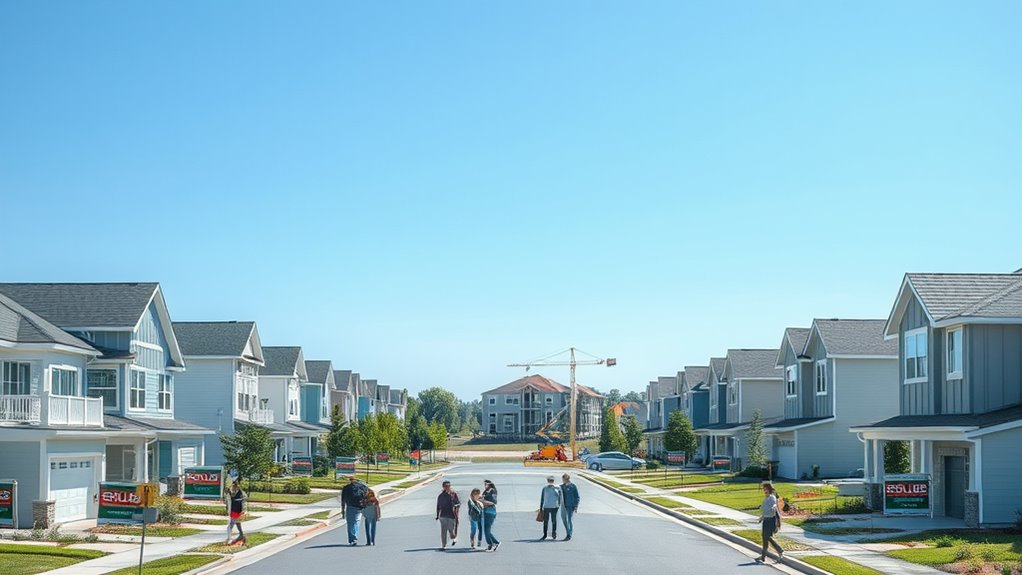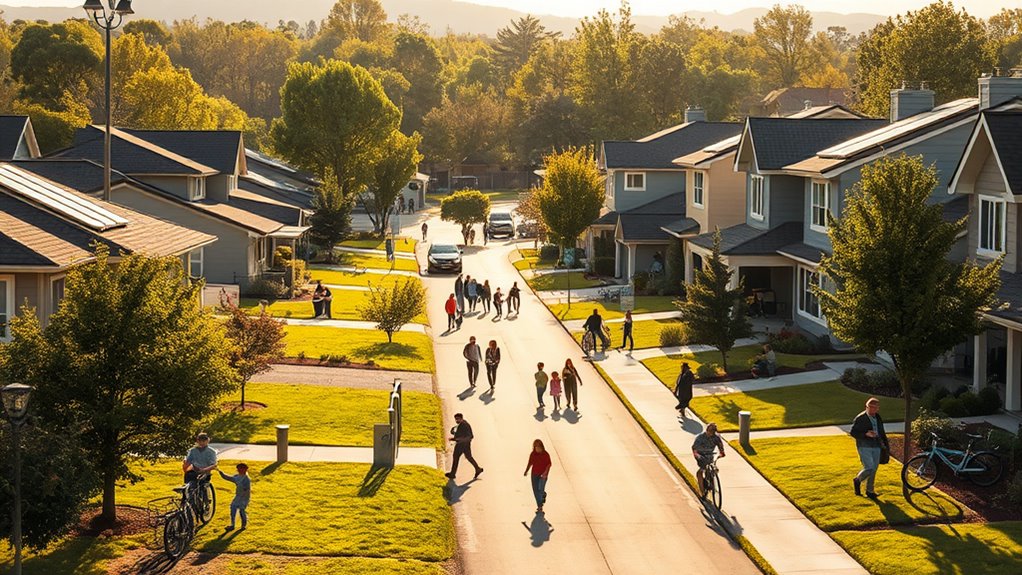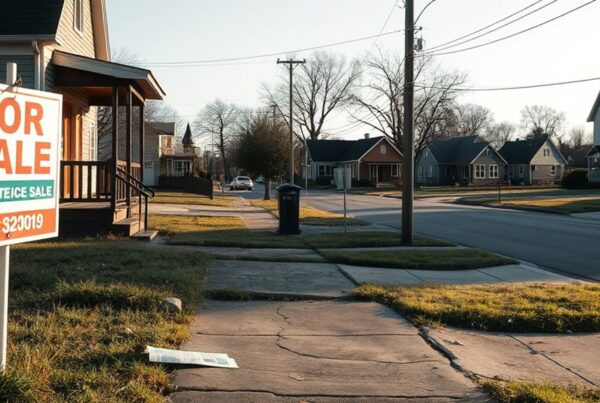A balanced housing market in 2025 will feature an 11.7% rise in existing home inventory, pushing the months supply to 4.1. Mortgage rates will stabilize around 6.3%, improving buyer affordability. Single-family home starts are expected to surge by 13.8%, adding 1.1 million units to the market. Job growth and rising wages will boost buyer confidence, while modest 2% home-price increases indicate stability. Understanding these dynamics will give you a clearer picture of the year ahead.
Key Takeaways
- A balanced housing market in 2025 features 4–6 months of inventory, offering equal opportunities for buyers and sellers.
- Existing home inventory is projected to rise by 11.7%, contributing to market stability and affordability.
- Mortgage rates stabilizing around 6.3% will enhance buyer affordability and encourage consistent market activity.
- New home construction is expected to increase by 13.8%, reaching 1.1 million units, further balancing supply and demand.
- Home-price growth is projected at 2%, ensuring stable and predictable pricing in a balanced market.
Key Factors Driving a Balanced Housing Market
As housing inventory levels are projected to rise by 11.7% for existing homes in 2025, you’ll see a shift toward a more balanced market, with supply increasing to 4.1 months. This growth in housing supply, combined with stable mortgage rates averaging around 6.3%, will enhance affordability and encourage more buyers to enter the market. Single-family home starts will also surge by 13.8%, reaching approximately 1.1 million units, further bolstering inventory levels and meeting demand. Job growth and rising wages will play a critical role in boosting buyer confidence, making homeownership more attainable. With more options available and less competition, home prices are expected to stabilize, reducing the pressure on buyers. Investors may also consider real estate crowdfunding to diversify their portfolios without the need for large capital. These factors—higher inventory levels, steady mortgage rates, increased home starts, and improved economic conditions—will collectively drive a balanced market, ensuring a healthier equilibrium between supply and demand while fostering greater accessibility for prospective homeowners.
Impact of Mortgage Rates on Market Equilibrium
Mortgage rates stabilizing around 6.3% in 2025 will enhance buyer affordability, easing pressure on purchasing decisions. You’ll likely see increased buyer activity as rates move closer to this range, reducing the lock-in effect and supporting inventory growth. This shift will contribute to a more balanced equilibrium between supply and demand.
Rate Stabilization Effects
When mortgage rates stabilize around 6.3% in 2025, housing affordability is likely to improve, encouraging more buyers to participate. This stabilization will ease the financial burden on buyers, though interest rates in the 6% range may still deter some existing homeowners from selling due to the lock-in effect, limiting existing home inventory. However, an anticipated 11.7% rise in inventory will help create a more balanced market, offering more choices for buyers and stabilizing home prices. The real estate market will benefit from this equilibrium, as mortgage rates no longer fluctuate drastically, providing predictability. While the lock-in effect may constrain supply growth, the gradual easing of rates will help mitigate its impact. Investors seeking steady income may also explore income-producing assets like rental properties, which historically offer robust returns. Overall, rate stabilization in 2025 will foster a healthier, more accessible housing market.
Buyer Affordability Shifts
Buyer affordability in 2025 will hinge on the interplay between mortgage rates at 6.3% and the 11.7% rise in existing home inventory. As new construction adds 1.1 million single-family homes, increased supply will help temper price growth to a modest 2%. The balanced market emerging from this dynamic will ease pressures, but persistent lock-in effects may still constrain overall inventory growth. Comparative Market Analysis can further aid in understanding how these factors influence local market dynamics.
- Lower mortgage rates at 6.3% compared to 7% in early 2025 will bring monthly payments down, improving buyer affordability.
- Inventory growth of 11.7% will expand options, reducing competition and stabilizing home prices.
- New construction will contribute 13.8% more supply, further supporting a balanced market.
With these shifts, you’ll see a more accessible housing market, where affordability aligns with supply and demand.
Inventory Trends and Their Role in Stability

As inventory levels grow, the housing market’s shift toward greater stability becomes increasingly evident, with existing home inventory projected to rise by 11.7% by 2025. This increase contributes directly to a more balanced market, as the months supply of homes improves from 3.7 to 4.1 months, signaling a healthier supply-demand dynamic. New construction plays a pivotal role in this trend, with single-family home starts expected to climb by 13.8%, reaching 1.1 million units. This rise in inventory alleviates the pressure on home prices, particularly in markets that have historically experienced limited housing stock. Buyers benefit from increased options and extended decision-making timelines, fostering a more stable environment. The combination of rising existing home inventory and new construction guarantees that the market moves toward equilibrium, offering both affordability and stability in the long term. Strong local amenities continue to attract renters and buyers, further supporting market balance.
Price Dynamics in a Balanced Real Estate Environment
You’ll likely see price stability trends emerge as supply and demand balance improves, with average home-price growth projected at 2% in 2025. Increased inventory, expected to rise by 11.7%, will ease pressure on prices in most regions, though local dynamics may cause variations. Economic factors like mortgage rates near 6% and shifting demographics will shape pricing outcomes across markets. Emerging markets show potential for high returns as rental demand continues to grow.
Supply and Demand Balance
With inventory projected to reach 4.1 months in 2025, up from 3.7 months, the housing market will shift toward a more balanced supply and demand dynamic. This equilibrium will help stabilize home prices, with CoreLogic predicting average growth slowing to around 2%. Rising mortgage rates, projected at 6.3%, will influence buyer activity, while an 11.7% increase in existing homes inventory will provide more options for buyers. Cities like Austin, with a median home price of $525,000, will benefit from this balance as affordability improves.
- Inventory expansion: A higher supply of homes will ease competition, reducing upward pressure on prices.
- Mortgage rate impact: Elevated rates may temper buyer enthusiasm, but a balanced market dynamic will sustain steady home sales.
- Seller participation: The lock-in effect may lessen as sellers with favorable rates consider listing, enhancing market fluidity. A balanced market guarantees stability without extreme price swings.
Price Stability Trends
The housing market in 2025 will likely achieve price stability as inventory growth and moderate buyer demand counterbalance past years’ rapid price increases. Home price growth is expected to slow to around 2% as existing home inventory rises by 11.7%, easing affordability challenges in many regions. Mortgage rates hovering near 6% will further temper buyer enthusiasm, limiting the potential for significant price increases. Markets with abundant supply may see price stabilization or even declines, while areas with limited inventory could still experience modest price increases. This nuanced dynamic reflects the shift toward a balanced market, where rising inventory levels and controlled buyer demand create a more predictable pricing environment. Price stabilization will depend on the continued alignment of these factors, offering buyers more options and sellers realistic expectations.
Influencing Economic Factors
As the housing market shifts toward balance in 2025, several key economic factors will shape price dynamics. The interplay between existing home inventory and construction levels will stabilize home prices, with inventory expected to rise by 11.7% and single-family home construction increasing by 13.8%. These factors reduce upward pressure on prices, pushing growth to an average of 2%. The average rate for a 30-year fixed mortgage will likely hover around 6%, enhancing affordability for buyers and further tempering price escalation. Additionally, the months’ supply of homes will improve from 3.7 to 4.1 months, signaling a shift from a strong sellers market to a balanced market. Investors can leverage property analysis tools to evaluate these trends and make informed decisions in this evolving market environment.
- Increased existing home inventory reduces competition.
- Steady interest rates support buyer affordability.
- Higher construction levels alleviate supply constraints.
Shifts Between Buyer and Seller Market Conditions

Even though the housing market has leaned heavily towards sellers in recent years, 2025 could bring a shift towards more balanced conditions. A balanced housing market typically features a 4-to-6-month supply of homes, allowing for equitable negotiation power. In 2025, existing home inventory is projected to rise by 11.7%, easing the intense seller’s market witnessed earlier. This increase in supply, combined with new construction growing by 13.8%, will likely stabilize home prices, with modest growth of just 2%. While mortgage rates are expected to hover around 6.3%, they’ll still support affordability, boosting buyer activity. These market dynamics could reduce pressure on home prices, making buying a home more accessible. As a result, you’ll see a shift away from the extreme seller’s market, creating opportunities for both buyers and sellers. The interplay between supply, demand, and affordability will drive the market closer to equilibrium.
Economic Influences Shaping the 2025 Housing Landscape
Economic factors will play a central role in shaping the 2025 housing landscape, influencing affordability and market dynamics. High mortgage rates, projected at 6.3%, will challenge homebuyers, but stable rent prices and rising wages could offset these pressures, enhancing housing affordability. Market conditions will also shift as existing home inventory grows by 11.7%, offering buyers more options and fostering balance. Here’s how the economic landscape will shape the market:
- Home Sale Prices: Expect a moderate 3.7% increase, reflecting a tempered growth trajectory that aligns with broader economic trends.
- Buyer Confidence: A 2% to 9% rise in existing home sales signals improved buyer confidence, driven by favorable economic indicators.
- Policy Impact: Trump administration policies could play a pivotal role in recovery, though broader economic conditions will likely exert more influence on housing trends.
A new sentence with cash flow analysis and the rest of the sentence. This interplay of economic forces will define the 2025 housing market, balancing affordability and demand.
Conclusion
By 2025, a “balanced” housing market might just mean you’re equally frustrated whether you’re buying or selling—mortgage rates tease stability, inventory pretends to recover, and prices stubbornly hover just out of reach. Naturally, economic shifts will promise equilibrium while delivering chaos. You’ll watch as buyer and seller advantages flip like a coin, leaving you to wonder if balance is a myth or just a cruel joke. Data says it’s coming; reality laughs.




